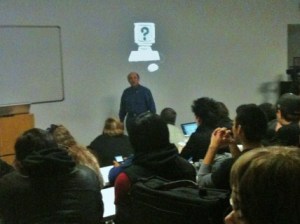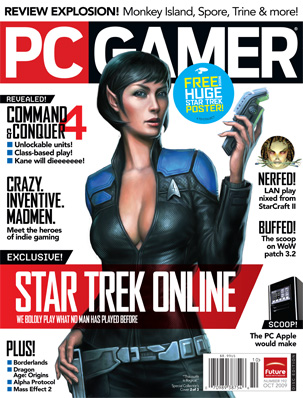 Though this post has been around since mid-summer it only just recently came to my attention via a student of mine who saw Stephen Totillo’s post at Kotaku. In it, Chris Crawford talks about turning sixty and looking at his self-perceived lack of success with the StoryTron project and interactive storytelling in general. Last year, Chris was a guest speaker at Columbia College Chicago visiting the Interactive Arts and Media department, where he talked about many things, including interactive storytelling. His presentation was dynamic, thought-provoking, and a little controversial, which meant it was typical Chris.
Though this post has been around since mid-summer it only just recently came to my attention via a student of mine who saw Stephen Totillo’s post at Kotaku. In it, Chris Crawford talks about turning sixty and looking at his self-perceived lack of success with the StoryTron project and interactive storytelling in general. Last year, Chris was a guest speaker at Columbia College Chicago visiting the Interactive Arts and Media department, where he talked about many things, including interactive storytelling. His presentation was dynamic, thought-provoking, and a little controversial, which meant it was typical Chris.
In his blog post Chris talks about hitting sixty and looking backward at the fact that he has not succeeded to the level he’d hoped for with the StoryTron project. He laments that failure but ends with the resolution that he’s going to dig in and take another shot at it.
I heard about this and read Chris’s post while here in Vancouver at the iDMAa 2010 conference, subtitled “The Digital Narrative”. And while conference is about digital art, media, and narrative in all it’s forms there’s been significant conversation about narrative and interactive storytelling. The coincidence of reading about Chris’s introspection while at this conference has not been lost on me.
Personally, I do not think that computer-moderated dynamically generated narrative will succeed to the utopian level that Chris seeks simply because the task is too complex and the output too subtle. I come from a strong table-top role-playing game background and I know the difficulty of teaching a human being (let alone a computer) how to tell good interactive stories. (Everyone who’s had a crappy gamemaster raises your hand…) I also oversee the Castle Marrach which is an online, text-based multiple-user role-playing game (basically a MUD) where a great deal of the storytelling us shared amongst the players. There, some players understand storytelling (in this case cooperative), but many do not on anything beyond a fundamental level. Storytelling and story generation is hard enough with human beings that I find it hard to believe that it is possible to create a computer surrogate that will satisfy our needs as story participant.
That said, I want to be wrong and I hope that Chris succeeds. But even if he does not succeed I am heartened that his endeavor is going to continue. Chris is his post is looking at his failure to bring the StoryTron to a final product (in the loosest sense) or even produce a viable framework that could be built upon. While that may be true, I think Chris fails to recognize the value he’s generated just by taking the journey. The discourse around interactive storytelling has been elevated due to his efforts, his ideas, his energy, his writings, his provocation, and his perhaps Quixotic pursuit of the goals of StoryTron. Thank you, Chris Crawford.
I do not think that StoryTron will ever do what Chris wants it to do, but boy if it ever does I will happily be there to experience it, edible crow in hand.


